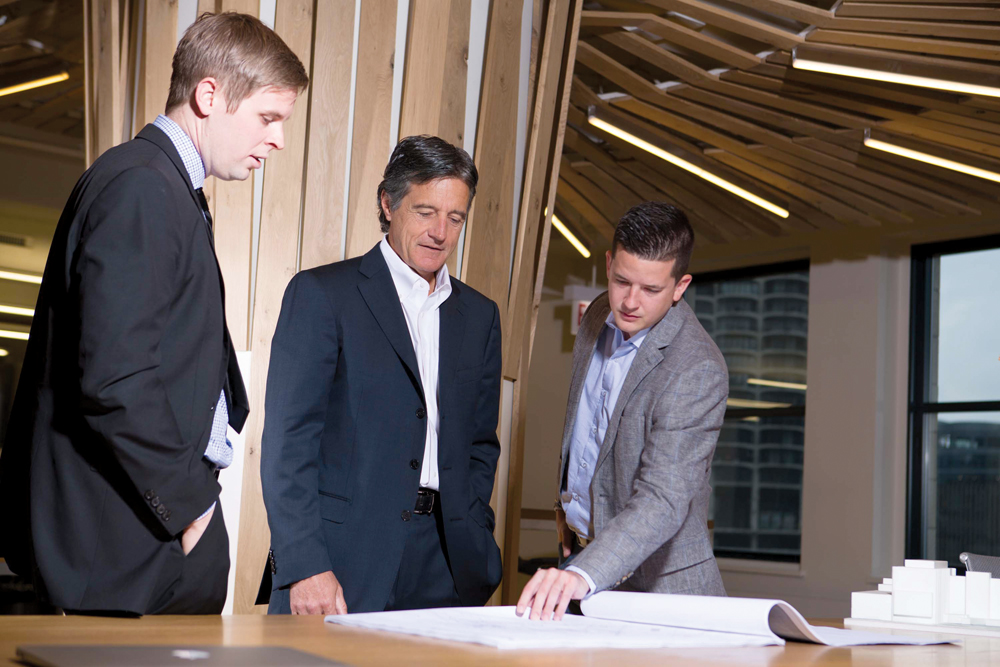Design-build firm Clayco has launched an investment arm called Treehouse Adventures to provide financing and operational infrastructure to startups, including those serving the AEC industry.
“We see a lot of opportunities in construction services,” says Michael Latiner, who joined Clayco last November as Treehouse’s President and Principal.
The goal is to create an environment where fledgling companies can concentrate on innovation and worry less about running a business. Clayco has dedicated the 14th floor of its headquarters in Chicago to provide space for the startups.
Treehouse’s first investment is Chicago-based Ventana Design-Build Systems, a five-month-old company that designs, supplies, and installs high-performance glass curtain wall façade systems. Latiner says Ventana’s President, Bob Trainor (center in photo, flanked by VPs Marty Trainor, left, and Ryan Murphy), was known in the business and had the ideas and processes, but needed Clayco’s operational backbone for support. “We were able to get them up and running in a week,” says Latiner.
Trainor says that Treehouse uses Clayco’s back-office services to provide marketing, IT, legal, and accounting support. It also provides an experienced senior management team and a network of relationships that startups like Ventana can leverage.
Treehouse doesn’t have a dedicated fund set aside for investment, but Latiner says he anticipates investing in two or three companies a year. A second deal has already been cut, with a technology startup whose expertise is making buildings smarter.
Read about more innovations from BD+C's 2014 Great Solutions Report.
Related Stories
| Mar 21, 2014
Forget wood skyscrapers - Check out these stunning bamboo high-rise concepts [slideshow]
The Singapore Bamboo Skyscraper competition invited design teams to explore the possibilities of using bamboo as the dominant material in a high-rise project for the Singapore skyline.
| Mar 21, 2014
Pier Carlo Bontempi to receive Richard H. Driehaus Prize from Notre Dame
Established in 2003 by the Notre Dame School of Architecture, the $200,000 Richard H. Driehaus Prize is awarded to a living architect whose work embodies the highest ideals of traditional and classical architecture in contemporary society, and creates a positive cultural, environmental and artistic impact.
| Mar 21, 2014
How to get more referrals
If you’re having a hard time attracting new referrals, here are a few techniques for increasing the number of interactions with potential clients.
| Mar 20, 2014
Common EIFS failures, and how to prevent them
Poor workmanship, impact damage, building movement, and incompatible or unsound substrate are among the major culprits of EIFS problems.
| Mar 20, 2014
D.C. breaks ground on $2B mega waterfront development [slideshow]
When complete, the Wharf will feature approximately 3 million sf of new residential, office, hotel, retail, cultural, and public uses, including waterfront parks, promenades, piers, and docks.
| Mar 20, 2014
13 dazzling wood building designs [slideshow]
From bold structural glulam designs to striking textured wall and ceiling schemes, these award-winning building projects showcase the design possibilities using wood.
| Mar 20, 2014
Fluor defines the future 7D deliverable without losing sight of real results today
A fascinating client story by Fluor SVP Robert Prieto reminds us that sometimes it’s the simplest details that can bring about real results today—and we shouldn’t overlook them, even as we push to change the future state of project facilitation.
| Mar 19, 2014
Architecture Billings Index shows slight improvement
The American Institute of Architects (AIA) reported that the February ABI score was 50.7, up slightly from a mark of 50.4 in January.
| Mar 19, 2014
Gehry, Zaha, Foster, Meier: Vote for your top 'starchitect' in this March Madness design legends tourney
Fast Company's Bracket Madness tournament pits 32 designers against each other to see who truly is the world's greatest living designer.
| Mar 19, 2014
Is it time to start selecting your own clients?
Will 2014 be the year that design firms start selecting the clients they want rather than getting in line with competitors to respond to RFPs? That’s the question posed by a recent thought-provoking article.

















